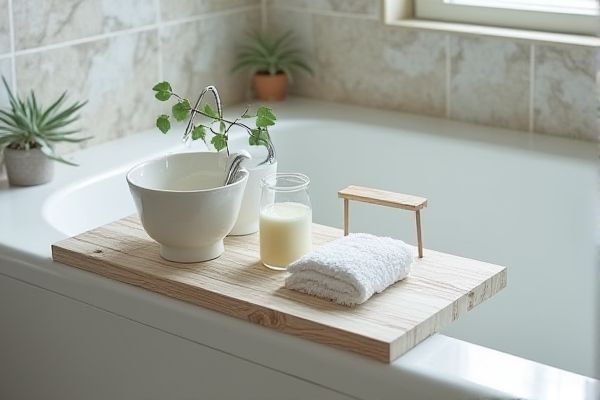
A bath caddy offers a larger, often adjustable surface with compartments for books, tablets, candles, and drinks, enhancing your bath experience by keeping everything within easy reach. To discover which option best suits your relaxation needs and bathroom setup, continue reading the rest of the article.
Table of Comparison
| Feature | Bath Caddy | Bath Tray |
|---|---|---|
| Definition | A storage accessory designed to sit across the bathtub, holding bath essentials. | A flat platform placed over the bathtub to hold items like books, drinks, or gadgets. |
| Material | Usually wood, bamboo, or plastic with waterproof finish. | Commonly wood, bamboo, metal, or acrylic with water-resistant properties. |
| Storage Features | Multiple compartments, slots, and holders for soap, candles, glasses, and tablets. | Limited compartments; mostly a flat surface with occasional slots. |
| Adjustability | Often adjustable to fit different tub widths. | May be fixed size or adjustable depending on design. |
| Purpose | Organized storage and access to bath essentials during a soak. | Convenient surface for resting items while bathing. |
| Price Range | Typically $20 - $70. | Typically $15 - $60. |
Introduction: Bath Caddy vs Bath Tray
Bath caddies and bath trays both serve as practical accessories designed to enhance the bath experience by providing convenient storage for books, candles, drinks, or personal care items. Bath caddies often feature adjustable or expandable designs made from durable materials like bamboo or metal, allowing them to fit across various bathtub sizes securely. Bath trays tend to be simpler, offering a flat, stable surface without extension mechanisms, ideal for holding a few essential items within easy reach during a relaxing soak.
Definition and Purpose
A bath caddy is a specialized accessory designed to stretch across a bathtub, providing a sturdy surface to hold items such as books, tablets, candles, or beverages while bathing. A bath tray serves a similar function but often includes compartments or holders specifically crafted for bath essentials like soap, sponges, and relaxation accessories. Both products aim to enhance the bath experience by offering convenient storage and organization within arm's reach during a soak.
Material Comparison
Bath caddies and bath trays differ primarily in material, with bath caddies often crafted from bamboo, teak, or stainless steel for durability and water resistance, while bath trays are commonly made from lightweight wood, plastic, or metal. Bamboo and teak provide natural resistance to moisture and mold, making bath caddies ideal for frequent bath use. Plastic trays, though less durable, offer affordability and easy maintenance, whereas metal trays may require coating to prevent rust.
Design and Style Differences
Bath caddies typically feature an extended, ergonomic design with adjustable book or tablet rests, offering enhanced functionality and support for longer bath sessions. Bath trays generally showcase a simpler, flat structure, emphasizing minimalist aesthetics and easy placement across narrower tubs. The choice between them depends on preference for either versatile, multi-purpose features or sleek, compact styling in bathroom accessories.
Storage Capacity and Functionality
Bath caddies typically offer greater storage capacity with multiple compartments designed to hold books, tablets, wine glasses, and bath essentials securely, enhancing functionality during relaxation. Bath trays usually provide a simpler, flat surface sufficient for holding a book or drink but lack extensive storage features. Choosing between a bath caddy and a bath tray depends on the user's need for organized storage versus minimalistic utility.
Ease of Use and Installation
Bath caddies offer greater ease of use with adjustable arms that fit most tub sizes, requiring no tools for installation. Bath trays typically rest on the tub edges but may need careful positioning to avoid slipping, offering a simpler but less secure setup. Your choice depends on whether you prioritize quick setup or a more customizable and stable option.
Durability and Maintenance
Bath caddies typically offer enhanced durability due to their sturdier materials such as bamboo, teak, or stainless steel, designed to withstand frequent exposure to water and humidity. Bath trays, often made from lighter materials like plastic or less robust wood, require more careful maintenance to prevent warping or mold buildup. Regular cleaning and drying extend the lifespan of both, but bath caddies generally demand less frequent replacement and offer superior resistance to bath-related wear and tear.
Price Range and Value
Bath caddies typically range from $50 to $150, offering robust features like adjustable bookstands and wine glass holders that enhance your relaxation experience. Bath trays are often more affordable, priced between $20 and $70, providing simple functionality such as holding a book or tablet securely. Choosing the right option depends on your budget and desired added features, ensuring you get the best value for your personal comfort.
Aesthetic Appeal
Bath caddies often feature sleek, modern designs crafted from materials like bamboo or teak, enhancing the bathtub's overall aesthetic appeal with natural textures and warm tones. Bath trays, typically slimmer and simpler, offer minimalist charm that complements contemporary bathroom decor while maintaining unobtrusive functionality. Choosing between a bath caddy and bath tray depends on whether you prioritize a statement piece or subtle elegance in your bathroom's visual harmony.
Which Is Best for Your Bathroom?
Choosing between a bath caddy and a bath tray depends on your bathroom's size and your relaxation needs. A bath caddy typically offers more storage and compartments for books, candles, and drinks, making it ideal for a luxurious bath experience. Your best option balances functionality and space, ensuring comfort without cluttering your bathroom.
 homyna.com
homyna.com